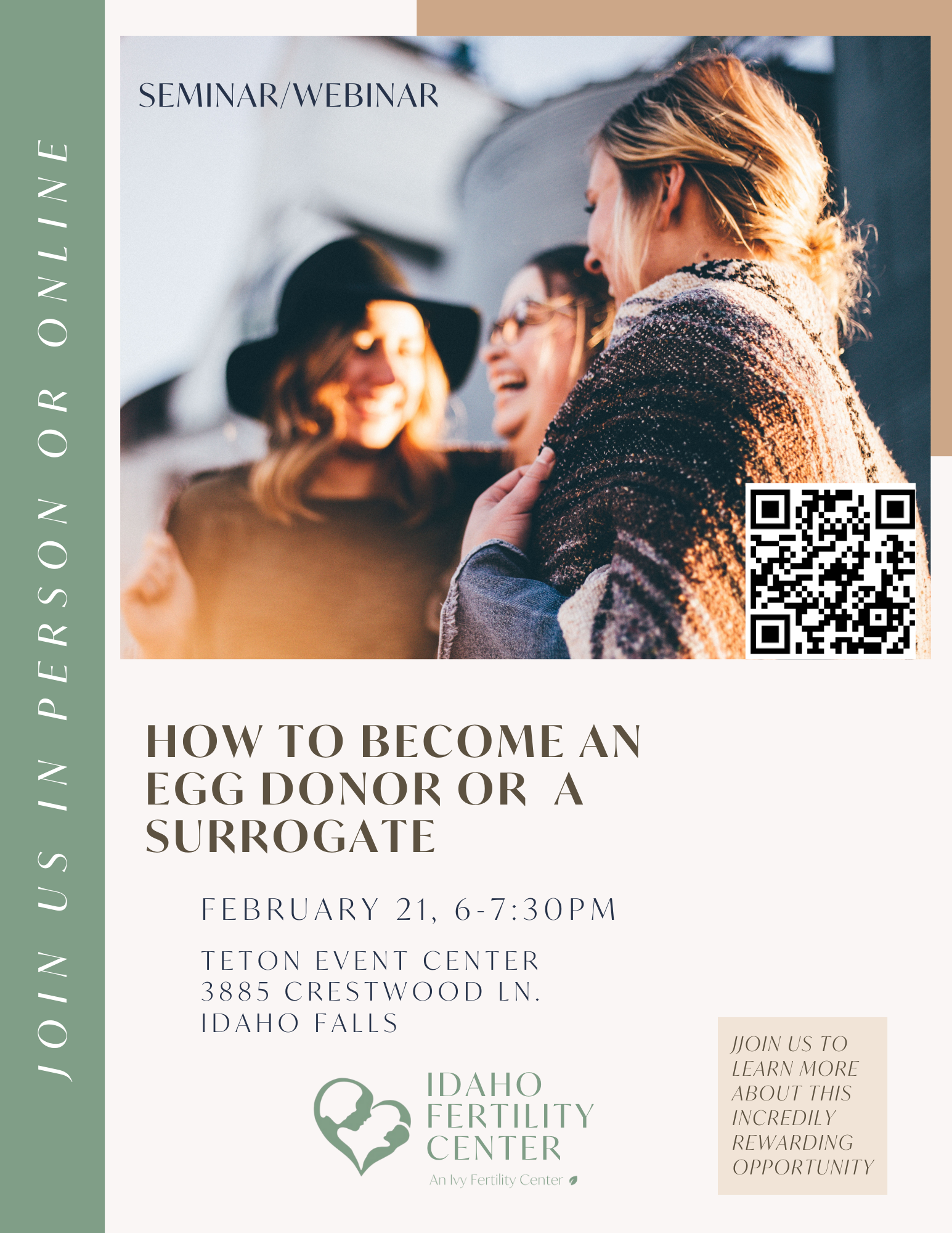What is In Vitro Fertilization?
In Vitro Fertilization (IVF) is the process where the female patient is stimulated with medication to make several eggs grow within the ovary. The eggs are then collected through the vagina using a sonogram-guided needle under sedation. Sperm is then added to the eggs to allow fertilization to take place. Fertilized eggs are then placed back in the uterus a few days later. IVF is effective for different types of infertility, including tubal disease, male factor, ovulation disorders, endometriosis, and unexplained infertility.
How much does it cost?
The amount will vary, as each patient/couple receives a customized treatment plan. We verify insurance coverage prior to your initial visit. After meeting with your physician and establishing a plan, the costs associated can be determined.We offer third-party financing and discount programs. Please speak to our financial counselor for additional questions.
The IVF Cycle
Evaluation
A full evaluation confirms the need for IVF and prepares for the cycle, which includes extensive patient education and a few diagnostic tests at one of our Utah clinics (or at one of our out-of-state offices). This preparation may take 1-2 months.
Ovulation stimulation
Beginning with the onset of a woman’s menstrual cycle, two hormonal medications are given, one to control when a woman will ovulate and the other to stimulate egg production. These daily hormonal injections occur over 10 to 12 days. Two or three transvaginal ultrasounds are performed to assess the growth and maturity of the follicles containing the eggs. Once mature (ready to ovulate), a third hormone is given to trigger the eggs’ release (ovulation). This is usually cycle day 10 – 12.
Oocyte retrieval
One hour prior to the eggs releasing from the ovary, they are aspirated through a needle into a test tube. Anesthesia provides no pain, while the transvaginal ultrasound guides the needle into the separate follicles to aspirate the eggs. An average egg yield is about 15, but varies widely.
Laboratory
The eggs are mixed or injected (ICSI) with the husband’s sperm. The lab is equipped with state-of-the-art instruments, microscopes, incubators, airflow hoods, and room filters to ensure the highest quality outcomes. Typically, 60-70% of eggs retrieved will become fertilized (the same as in nature). These fertilized eggs are incubated over 3 to 5 days, until ready to enter the uterus.
Embryo transfer
Three to five days after the egg retrieval, following evaluation of the quality of the developing embryos, a decision is made by the patients and the physician as to how many to transfer to the uterus. Your doctor will discuss the number of embryos to transfer that will provide the highest probability of a successful, healthy pregnancy while still trying to minimize the probability of a high order multiple pregnancy. You will receive information on your embryos and a picture of your embryos. Usually, patients decide to transfer 1 to 2 embryos. In an atraumatic catheter, embryos are transferred through the cervix and into the uterus under ultrasound guidance. The procedure is pain-free. It is often a very reassuring experience to see the embryos placed into the womb. High-quality embryos that remain from the cycle can be cryopreserved on day 5 or 6 and stored for future attempts.
Luteal phase monitoring
The patient takes progesterone daily while waiting for the pregnancy test. We typically wait 10 days after the embryo transfer to determine whether an embryo implanted. Once it takes hold, the hormone it produces is detected in the mother’s blood stream. This confirms an early pregnancy.
Implantation
Successful implantation marks the beginning of a 9-month gestation. The mother-to-be will return to her personal physician at 9 weeks gestation for prenatal care. If an embryo did not implant, the patient can use the frozen embryos or begin a new treatment cycle.
Frequently Asked Questions
What effect does female age have on getting pregnant and staying pregnant?
A woman’s fertility begins to fall in her early to mid- thirties, mostly due to a decrease in the number and quality of eggs in her ovaries. This varies from woman to woman; unfortunately, there is no way to reliably predict fertility decline. The condition of your eggs also changes as you age; they have a higher rate of chromosomal anomalies.
Am I a good candidate for IVF?
If you have any of the following conditions, you may be a good candidate for IVF:
- Ovulatory dysfunction
- Male factor infertility
- Blocked, diseased, or absent fallopian tubes
- Pelvic inflammatory disease
- Unexplained infertility
- Failed conventional fertility methods with oral medication, injectable drugs, and/or intrauterine insemination (IUI)
- Endometriosis
- PCOS
- Uterine factors or cervical mucus problems
On which day should the embryos be placed back into the uterus?
We will contact you to schedule the embryo transfer date. Embryos are typically transferred back to the uterus on day 5. Embryos are grown to the blastocyst stage which generally occurs on day 5 and blastocyst embryo transfers yield the highest implantation rates and pregnancy outcomes.
How many embryos should we implant?
An advantage of IVF is the ability to control the number of embryo(s) to be transferred to the uterus. Our goal is one healthy baby, and Elective Single Embryo Transfer (eSET) is now being utilized regularly, thus minimizing the risk of multiples. Based on your particular circumstances, you and your physician will discuss the benefits of transferring one embryo to the uterus, and cryopreserving or freezing the remaining viable embryos for future use.
Should we have genetic testing Preimplantation Genetic Screening (PGS) or Preimplantation Genetic Diagnosis (PGD)?
PGS or preimplantation genetic screening, is a genetic test performed on embryos produced using IVF. PGS gives information about embryos’ genetic health to help you and your physician select the best embryo for transfer and improve your chance of achieving a successful pregnancy.
PGD can be used to target specific genetic diseases when one or both parents are carriers of, or affected by, a known genetic diagnosis. Alternatively, PGD can be applied to screen embryos of pregnancy losses or recurrent IVF failures. In some circumstances, PGD may be appropriate to select embryos for HLA-typing, or for the detection of genes associated with devastating chronic diseases and some types of cancer.
If pregnancy does not occur in the first IVF cycle, is there reason to try again?
In Vitro Fertilization is a gold standard of treatment for infertility, and it increases the likelihood of pregnancy well above the natural monthly conception rate. UFC achieves exceptionally high success rates, but we acknowledge that not all patients find success on their first attempt.Three things help us evaluate and determine if another round of IVF is right for you:
- Quality of Embryos
- Receptivity of Uterus
- Embryo Transfer Technique
How is the gestational age of my pregnancy calculated?
Gestational age is normally calculated by a woman’s Last Menstrual Period (LMP). That means that she is considered 2 weeks pregnant at ovulation (which is the same time as your egg retrieval). To calculate your gestational age, know that you are 2 weeks pregnant at your egg retrieval.
How is the gestational age of my pregnancy calculated?
Gestational age is normally calculated by a woman’s Last Menstrual Period (LMP). That means that she is considered 2 weeks pregnant at ovulation (which is the same time as your egg retrieval). To calculate your gestational age, know that you are 2 weeks pregnant at your egg retrieval.







